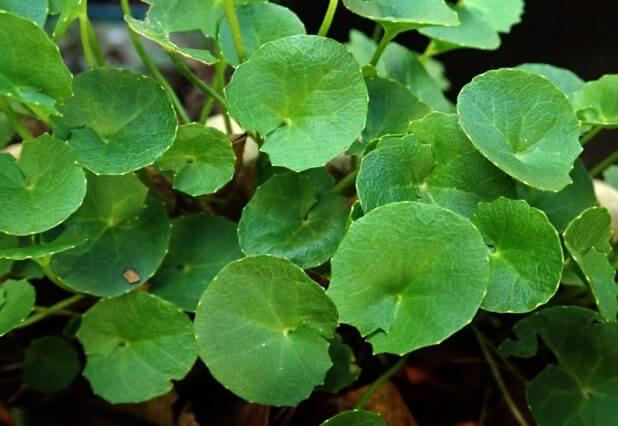Gotu kola or mandukaparni has been used for thousands of years to treat various diseases, it is widely used in China, India, and Indonesia. This is widely used to combat wounds, mental illnesses, and various skin ailments like psoriasis, leprosy, etc. it can also be used in managing respiratory symptoms. In Chinese medicine, this herb is called the fountain of life.
This is an Indian herb that is used for culinary and therapeutic purposes. It has been considered a brain tonic due to its beneficial neuroprotective properties.
Classification
Botanical Name
Centella Asiatica
Vernacular Names
- English – Marsh penny or Indian Penny
- Hindi – Bengseng, brahmi
- Bengali – Thulkuddi
- Malayalam – Karivanna
- Gujarati – Khandbrahmi
- Telugu – Manduka Brahmi
Habitat
Mandukaparni is a small trailing herb or perennial plant and is the only species of Centella found in India. Its roots are nodular and the stem is glabrous and strips are present that are of pink color, It has small fan-shaped green leaves that are fleshy, articulated, and dentate as well as reformed in structure. Its petioles are longer, and smoother on the upper part of the stem and on the bottom part it is hairy in structure. Its flowers are fascicled and umbels in pink and white color. Its fruits are oblong, laterally compressed, and hard from the pericarp, thickened with dull brown and woody white in color.
This plant is usually found in marshy places in tropical and subtropical regions all over the country, its founding soil is moist, fertile, and loose as well as clay-type soil.
This is found at the elevation of 2000 feet from sea level.
Ayurvedic Properties
- Rasa (Taste) – Tikta (Bitter).
- Guna (Quality) – Guru (Heavy), Snigadh (Moist)
- Veerya (Potency) – Sheet (Cool)
- Anuras – Kashaya (Astringent)
- Vipaka (Post digestive effect) – Madhur (Sweet).
- Karma (Action) – Balances the Kapha and Pitta dosha.
- Projyang (Part used) – Panchang is used (leaves, flowers, fruits, stem, roots)
Effects on Doshas
This herb helps to balance the Kapha and Pitta dosha with the help of tikta rasa.
Practical Uses
- Mandukparni contains various proteins, dietary fibres, carbohydrates, vitamins A, B, and C along with iron, sodium, calcium, and many more.
- Mandukparni has various properties in maintaining our body such as hepato-protection, anti- inflammation, anti-ulcerous, anti- epileptic, helps to stimulate the immune system, and may help in inducing sleep due to its calming and sedation property, anti-diabetic, cardiac tonic, anti-viral, anti-fungal and anti-bacterial with wound healing property.
- This herb is bitter in taste so it pacifies Kapha and pitta dosha.
- When it is used as paste form on the external surface of the skin it gives a result with its antioxidant properties or by increasing the blood circulation to that particular area.
- This herb helps to enhance memory power and thinking capacity with retention properties.
- Due to its tikta or bitter taste, it helps to enhance the digestive fire, and maintain the flora in the intestine.
- Due to its tikta rasa, it also helps in Kapha nihasaran, which rectifies the mucus in the respiratory system.
- It also acts on the pancreas so works like an anti-diabetic in nature.
- Due to its sweet post digestion effect and its cold potency, it works on milk production in females, it also helps in the detoxification of milk and female secondary reproductive organs.
- This herb helps in strengthening and also gives anti-aging effects, enhances the work capacity of every part of the body along with is helpful in maintaining a disease-free life.
- This is used in patients who are suffering from weakness in the brain, slurred speech, and various skin-related conditions, such as psoriasis, and fungal infections.
- This herb is also used in various bleeding disorders like epistaxis, gum bleeding and many more.
- This is used to expel the toxins from the body and pacify the fever.
- This herb is categorised in medhya Rasayana herbs by Acharya Charaka because it has a rejuvenating effect with anti-aging effects.
Dosage
- In decoction or in juice form – 10 to 20 ml can be used.
- In the form of powder – 2-4 grams.



